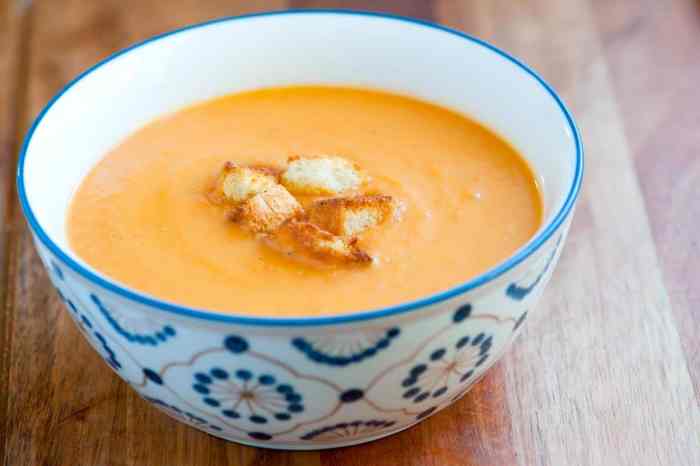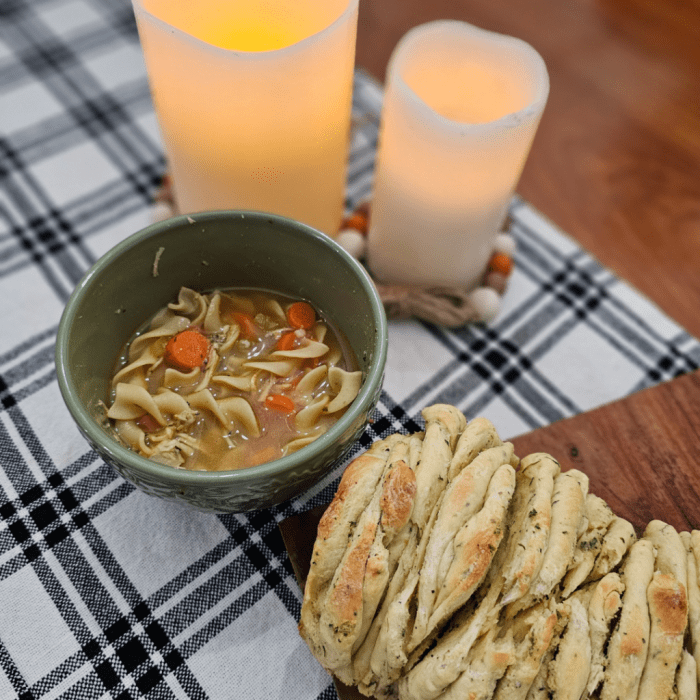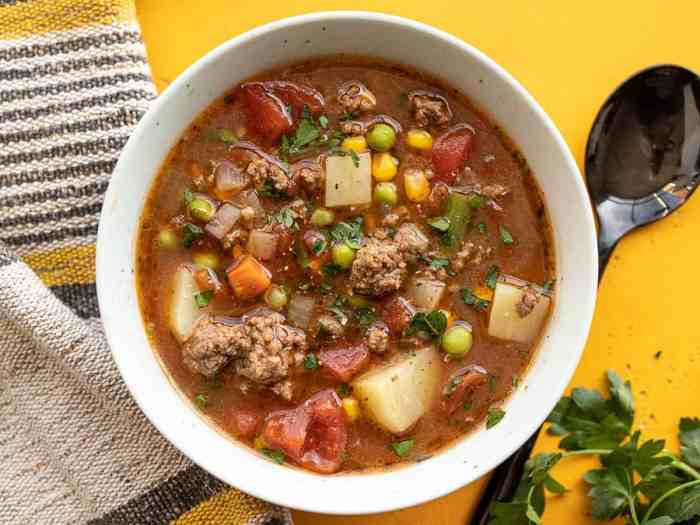Soup Starters: A Culinary Delight: Soup Starter Recipe
Soup starter recipe – Soup starters offer a delightful way to begin a meal, providing a warm, comforting, and flavorful prelude to the courses that follow. Their versatility allows for a wide range of culinary explorations, catering to diverse palates and dietary needs. From light and refreshing chilled options to rich and creamy concoctions, soup starters elevate the dining experience, offering both a sensory and nutritional boost.
Introduction to Soup Starters

Source: inspiredtaste.net
The appeal of soup as a starter lies in its ability to cleanse the palate, stimulate appetite, and provide a light yet satisfying introduction to the meal. The warmth of a broth-based soup can be particularly comforting in colder months, while chilled soups offer a refreshing contrast during warmer weather. Creamy soups, on the other hand, provide a luxurious and indulgent start to a meal.
Soup starters are common in many cultures, including French cuisine (soupe à l’oignon), Russian cuisine (borscht), and various Asian cuisines (miso soup, tom yum).
Recipe Selection: Types of Soup Starters
The following table showcases a variety of soup starters, highlighting their ingredients, flavor profiles, and preparation times. Each soup offers unique nutritional benefits, contributing to a well-rounded and healthy meal.
| Soup Type | Main Ingredients | Flavor Profile | Preparation Time |
|---|---|---|---|
| Creamy Tomato Soup | Tomatoes, vegetable broth, cream, basil | Sweet, tangy, savory | 30 minutes |
| French Onion Soup | Onions, beef broth, thyme, baguette, Gruyère cheese | Savory, caramelized, rich | 45 minutes |
| Chilled Cucumber Avocado Soup | Cucumber, avocado, lime juice, cilantro | Refreshing, creamy, herbaceous | 20 minutes |
| Miso Soup | Miso paste, seaweed, tofu, green onions | Savory, umami, subtly sweet | 15 minutes |
| Roasted Red Pepper and Corn Chowder | Roasted red peppers, corn, potatoes, vegetable broth, coconut milk | Sweet, smoky, slightly spicy | 45 minutes |
Nutritional benefits vary depending on the specific ingredients, but generally, soups are a good source of vitamins, minerals, and fiber. Creamy soups may be higher in calories and fat, while brothy soups are generally lower in calories. Chilled soups offer a lighter option, perfect for warmer weather.
A visual representation comparing caloric content could be a simple bar graph, with each soup’s name on the horizontal axis and the caloric content (per serving) represented by the height of the bar. For example, Miso soup might have the shortest bar, representing its lower calorie count, while Creamy Tomato soup might have a taller bar, indicating a higher calorie content.
Ingredient Sourcing and Preparation

Source: bullbutterco.com
Sourcing high-quality ingredients is crucial for creating flavorful and nutritious soups. For example, using ripe, vine-ripened tomatoes for the Creamy Tomato Soup will significantly enhance its flavor. Similarly, selecting a good quality beef broth for the French Onion Soup is essential. Fresh herbs and spices should also be prioritized whenever possible.
Proper preparation techniques are equally important. Vegetables should be finely chopped to ensure even cooking. Simmering broth allows the flavors to meld and deepen. For the vegetable broth recipe below, meticulous attention to detail will result in a flavorful base for many soups.
Step-by-Step Guide for Preparing Vegetable Broth from Scratch:
- Combine vegetable scraps (onion peels, carrot tops, celery leaves, etc.), 8 cups of water, and a bay leaf in a large pot.
- Bring to a boil, then reduce heat and simmer for at least 30 minutes, or up to 2 hours for a richer flavor.
- Strain the broth through a fine-mesh sieve or cheesecloth, discarding the solids.
- Season with salt and pepper to taste.
Cooking Methods and Techniques
Various cooking methods can be employed for preparing soup starters. Stovetop cooking offers precise temperature control, while slow cookers provide a hands-off approach, ideal for busy schedules. Instant Pots allow for quick and efficient cooking, particularly beneficial for recipes requiring longer simmering times. Cooking times will vary based on ingredient types and desired consistency. For example, delicate vegetables like spinach should be added towards the end of cooking to prevent overcooking, while heartier vegetables like potatoes may require a longer cooking time.
Potential challenges include uneven cooking, resulting in some ingredients being undercooked or overcooked. Solutions include chopping ingredients into uniform sizes and adding ingredients at appropriate times based on their cooking times. Another challenge is achieving the desired consistency; adding a thickening agent like cornstarch or flour can help achieve the desired creaminess.
Serving Suggestions and Presentation
Garnishes and accompaniments significantly enhance the flavor and visual appeal of soup starters. A simple garnish can transform a basic soup into a culinary masterpiece.
| Soup Type | Suggested Garnish | Accompaniment | Serving Temperature |
|---|---|---|---|
| Creamy Tomato Soup | Fresh basil, a swirl of cream | Grilled cheese croutons | Warm |
| French Onion Soup | Gruyère cheese, toasted baguette slices | Salad | Hot |
| Chilled Cucumber Avocado Soup | Chopped cilantro, a lime wedge | Toasted pita bread | Chilled |
| Miso Soup | Chopped green onions, sesame seeds | Sushi | Warm |
| Roasted Red Pepper and Corn Chowder | Chopped chives, a dollop of sour cream | Cornbread | Warm |
Plating soup starters attractively involves considering the soup’s color, texture, and temperature. Serving in stylish bowls and using garnishes strategically can elevate the presentation. Consider using contrasting colors and textures to create visual interest.
Recipe Variations and Adaptations

Source: budgetbytes.com
A delightful soup starter recipe can set the tone for any meal. For a creamy and elegant option, consider incorporating elements from simple cream soup recipes , perhaps adapting a lighter version to serve as a palate-cleansing prelude. The key is to maintain a balance of flavors and textures, ensuring your soup starter recipe complements, rather than overwhelms, the main course.
Adapting soup recipes for dietary restrictions is straightforward. Vegetarian and vegan versions can be created by substituting vegetable broth for meat broth and omitting dairy products. Gluten-free options can be achieved by using gluten-free bread for croutons or avoiding ingredients containing gluten. Spice levels can be adjusted by adding more or less chili flakes or other spices.
Creative variations abound. For instance, adding roasted butternut squash to the Creamy Tomato Soup would create a unique flavor profile. Experimenting with different herbs and spices allows for endless possibilities. Adjusting the salt and pepper levels allows for tailoring the flavor profile to individual preferences.
Pairing Soup Starters with Main Courses, Soup starter recipe
Pairing soup starters with main courses involves considering flavor profiles and textures. A light and refreshing soup starter would complement a richer main course, while a heavier soup might be better suited to a lighter main course. The goal is to create a balanced and harmonious dining experience.
- Creamy Tomato Soup: Paired well with grilled chicken or fish.
- French Onion Soup: Complements beef bourguignon or steak.
- Chilled Cucumber Avocado Soup: A perfect match for grilled shrimp or a light salad.
- Miso Soup: Excellent with sushi or other Japanese dishes.
- Roasted Red Pepper and Corn Chowder: Pairs well with tacos or grilled fish.
Top FAQs
Can I make soup starters ahead of time?
Many soup starters can be made a day or two in advance, allowing for efficient meal preparation. Store them properly refrigerated and reheat gently before serving.
What are some good vegetarian/vegan soup starter options?
Creamy vegetable soups (e.g., butternut squash, tomato), lentil soup, or chilled cucumber soup are excellent vegetarian and easily adaptable to vegan options by using plant-based milk/cream.
How do I prevent my soup from becoming too salty?
Add salt gradually throughout the cooking process, tasting frequently to adjust seasoning. Avoid over-salting the broth; you can always add more later but can’t remove excess salt easily.
What if my soup is too thick or too thin?
For a thicker soup, simmer uncovered to reduce liquid. For thinner soup, add more broth or water, a cornstarch slurry (cornstarch mixed with cold water), or pureed vegetables to thicken.
